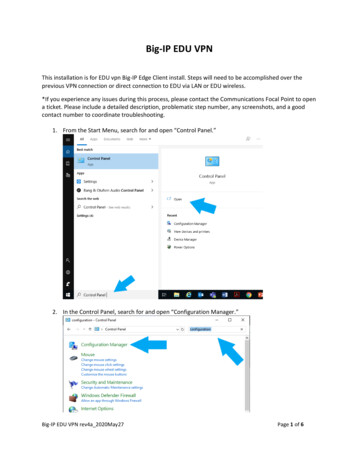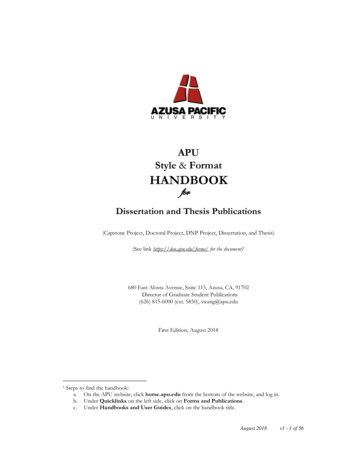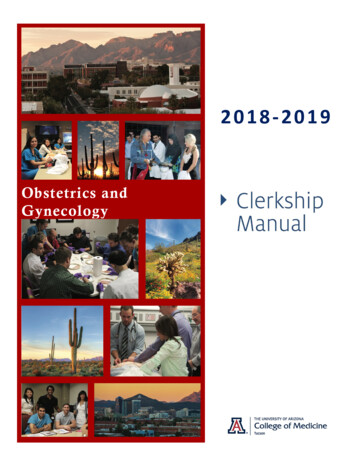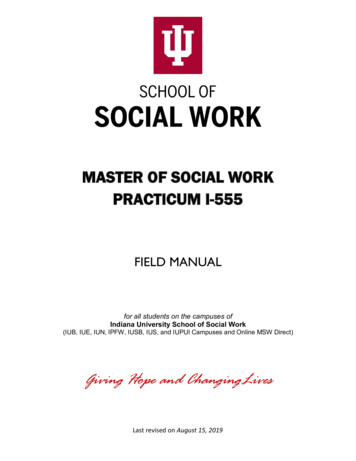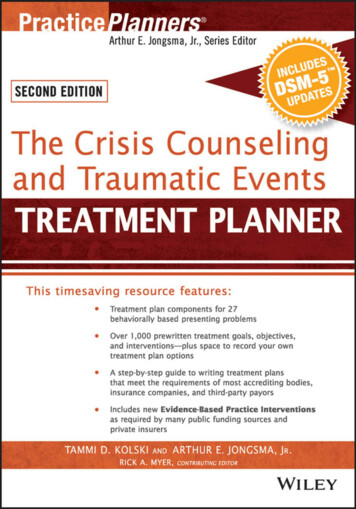
Transcription
The Crisis Counseling andTraumatic EventsTreatment Planner,with DSM-5 Updates,Second Edition
PracticePlanners SeriesTreatment PlannersThe Complete Adult Psychotherapy Treatment Planner, Fifth EditionThe Child Psychotherapy Treatment Planner, Fifth EditionThe Adolescent Psychotherapy Treatment Planner, Fifth EditionThe Addiction Treatment Planner, Fifth EditionThe Continuum of Care Treatment PlannerThe Couples Psychotherapy Treatment Planner, with DSM-5 Updates, Second EditionThe Employee Assistance Treatment PlannerThe Pastoral Counseling Treatment PlannerThe Older Adult Psychotherapy Treatment Planner, with DSM-5 Updates, Second EditionThe Behavioral Medicine Treatment PlannerThe Group Therapy Treatment PlannerThe Gay and Lesbian Psychotherapy Treatment PlannerThe Family Therapy Treatment Planner, with DSM-5 Updates, Second EditionThe Severe and Persistent Mental Illness Treatment Planner, with DSM-5 Updates, Second EditionThe Mental Retardation and Developmental Disability Treatment PlannerThe Social Work and Human Services Treatment PlannerThe Crisis Counseling and Traumatic Events Treatment Planner, with DSM-5 Updates, Second EditionThe Personality Disorders Treatment PlannerThe Rehabilitation Psychology Treatment PlannerThe Special Education Treatment PlannerThe Juvenile Justice and Residential Care Treatment PlannerThe School Counseling and School Social Work Treatment Planner, with DSM-5 Updates, Second EditionThe Sexual Abuse Victim and Sexual Offender Treatment PlannerThe Probation and Parole Treatment PlannerThe Psychopharmacology Treatment PlannerThe Speech-Language Pathology Treatment PlannerThe Suicide and Homicide Treatment PlannerThe College Student Counseling Treatment PlannerThe Parenting Skills Treatment PlannerThe Early Childhood Intervention Treatment PlannerThe Co-occurring Disorders Treatment PlannerThe Complete Women’s Psychotherapy Treatment PlannerThe Veterans and Active Duty Military Psychotherapy Treatment Planner, with DSM-5 UpdatesProgress Notes PlannersThe Child Psychotherapy Progress Notes Planner, Fifth EditionThe Adolescent Psychotherapy Progress Notes Planner, Fifth EditionThe Adult Psychotherapy Progress Notes Planner, Fifth EditionThe Addiction Progress Notes Planner, Fifth EditionThe Severe and Persistent Mental Illness Progress Notes Planner, Second EditionThe Couples Psychotherapy Progress Notes Planner, Second EditionThe Family Therapy Progress Notes Planner, Second EditionThe Veterans and Active Duty Military Psychotherapy Progress Notes PlannerHomework PlannersCouples Therapy Homework Planner, Second EditionFamily Therapy Homework Planner, Second EditionGrief Counseling Homework PlannerGroup Therapy Homework PlannerDivorce Counseling Homework PlannerSchool Counseling and School Social Work Homework Planner, Second EditionChild Therapy Activity and Homework PlannerAddiction Treatment Homework Planner, Fifth EditionAdolescent Psychotherapy Homework Planner, Fifth EditionAdult Psychotherapy Homework Planner, Fifth EditionChild Psychotherapy Homework Planner, Fifth EditionParenting Skills Homework PlannerVeterans and Active Duty Military Psychotherapy Homework PlannerClient Education Handout PlannersAdult Client Education Handout PlannerChild and Adolescent Client Education Handout PlannerCouples and Family Client Education Handout PlannerComplete PlannersThe Complete Depression Treatment and Homework PlannerThe Complete Anxiety Treatment and Homework Planner
PracticePlanners Arthur E. Jongsma, Jr., Series EditorThe Crisis Counseling andTraumatic EventsTreatment Planner,with DSM-5 Updates,Second EditionTammi D. KolskiArthur E. Jongsma, Jr.Rick A. Myer, Contributing Editor
This book is printed on acid-free paper.Copyright 2014 by Tammi D. Kolski and Arthur E. Jongsma, Jr. All rights reserved.Published by John Wiley & Sons, Inc., Hoboken, New Jersey.Published simultaneously in Canada.No part of this publication may be reproduced, stored in a retrieval system, or transmitted in any form orby any means, electronic, mechanical, photocopying, recording, scanning, or otherwise, except aspermitted under Section 107 or 108 of the 1976 United States Copyright Act, without either the priorwritten permission of the Publisher, or authorization through payment of the appropriate per-copy fee tothe Copyright Clearance Center, Inc., 222 Rosewood Drive, Danvers, MA 01923, (978) 750-8400, fax(978) 646-8600, or on the web at www.copyright.com. Requests to the Publisher for permission should beaddressed to the Permissions Department, John Wiley & Sons, Inc., 111 River Street, Hoboken, NJ 07030,(201) 748-6011, fax (201) 748-6008.Limit of Liability/Disclaimer of Warranty: While the publisher and author have used their best efforts inpreparing this book, they make no representations or warranties with respect to the accuracy orcompleteness of the contents of this book and specifically disclaim any implied warranties ofmerchantability or fitness for a particular purpose. No warranty may be created or extended by salesrepresentatives or written sales materials. The advice and strategies contained herein may not be suitablefor your situation. You should consult with a professional where appropriate. Neither the publisher norauthor shall be liable for any loss of profit or any other commercial damages, including but not limited tospecial, incidental, consequential, or other damages.This publication is designed to provide accurate and authoritative information in regard to the subjectmatter covered. It is sold with the understanding that the publisher is not engaged in renderingprofessional services. If legal, accounting, medical, psychological or any other expert assistance isrequired, the services of a competent professional person should be sought.Designations used by companies to distinguish their products are often claimed as trademarks. In allinstances where John Wiley & Sons, Inc. is aware of a claim, the product names appear in initial capital orall capital letters. Readers, however, should contact the appropriate companies for more completeinformation regarding trademarks and registration.For general information on our other products and services please contact our Customer Care Departmentwithin the United States at (800) 762-2974, outside the United States at (317) 572-3993 or fax (317) 572-4002.Wiley publishes in a variety of print and electronic formats and by print-on-demand. Some materialincluded with standard print versions of this book may not be included in e-books or in print-on-demand.If this book refers to media such as a CD or DVD that is not included in the version you purchased, youmay download this material at http://booksupport.wiley.com. For more information about Wileyproducts, visit www.wiley.com.Library of Congress Cataloging-in-Publication Data:Kolski, Tammi D.The crisis counseling and traumatic events treatment planner, with DSM-5 updates [electronic resource] /Tammi D. Kolski, Arthur E. Jongsma, Jr., ; Rick A. Myer, contributing editor.—2nd ed.1 online resource.—(Practiceplanners ; 298)ISBN 978-1-119-06315-5 (pbk.)ISBN 978-1-119-06447-3 (eMobi)ISBN 978-1-119-06412-1 (ePub)ISBN 978-1-119-06414-5 (ePDF)Proudly sourced and uploaded by [StormRG]Kickass Torrents TPB ET h33t1. Life change events—Handbooks, manuals, etc. 2. Psychic trauma—Handbooks, manuals, etc. 3.Crisis intervention (Mental health services)—Handbooks, manuals, etc. 4. Stress (Psychology)—Handbooks, manuals, etc. 5. Mental health counseling—Handbooks, manuals, etc. I. Jongsma, ArthurE., 1943- II. Myer, Rick. III. Title.RC455.4.L53362.2'04251—dc23Printed in the United States of America10 9 8 7 6 5 4 3 2 12012012996
As my only child transitions into college, the support and love from my husbandcontinues to encourage and enrich my life.Thank you, Russ and Ashleigh, for your heartfelt commitment to our family.— TDKTo new friends, Rodger and Ruth, who have significantly enriched our liveswhen we have learned to value such friendships as gifts from God.— AEJTo my family—my wife, Sarah, and daughters, Melinda and Allison.Thank you for the support and patience.— RAM
CONTENTSPracticePlanners Series PrefaceAcknowledgmentsIntroductionSample Treatment Planxixiii19Acute Stress DisorderAnxietyBullying VictimChild Abuse/NeglectCrime Victim TraumaCritical Incidents With Emergency Service Providers (ESPs)DepressionDisasterDomestic ViolenceJob LossMedically Caused Death (Adult)Medically Caused Death raumatic Stress Disorder (PTSD)School Trauma (College)School Trauma (Elementary)School Trauma (Pre-Elementary)School Trauma (Secondary)School Trauma (Staff)Sexual AssaultStalking VictimSudden/Accidental Death (Adult)Sudden/Accidental Death (Child)Suicide (Adult)Suicide 167176185194202212221229Indicates that selected Objectives/Interventions are consistent with those found in evidencebased treatments.ix
xCONTENTSWorkplace ViolenceAppendix A: Bibliotherapy SuggestionsAppendix B: Professional References for Evidence-BasedChaptersAppendix C: Objective InstrumentsAppendix D: Recovery Model Objectives and Interventions238246255266275
PRACTICEPLANNERS SERIES PREFACEAccountability is an important dimension of the practice of psychotherapy.Treatment programs, public agencies, clinics, and practitioners must justifyand document their treatment plans to outside review entities in order to bereimbursed for services. The books in the PracticePlanners series aredesigned to help practitioners fulfill these documentation requirementsefficiently and professionally.The PracticePlanners series includes a wide array of treatment planningbooks including not only the original Complete Adult PsychotherapyTreatment Planner, Child Psychotherapy Treatment Planner, and AdolescentPsychotherapy Treatment Planner, all now in their fifth editions, but alsoTreatment Planners targeted to specialty areas of practice, including: AddictionsCo-occurring disordersBehavioral medicineCollege studentsCouples therapyCrisis counselingEarly childhood educationEmployee assistanceFamily therapyGays and lesbiansGroup therapyJuvenile justice and residential careMental retardation and developmental disabilityNeuropsychologyOlder adultsParenting skillsPastoral counselingPersonality disordersProbation and parolePsychopharmacologyRehabilitation psychologySchool counseling and school social workSevere and persistent mental illnessSexual abuse victims and offendersxi
xii THE CRISIS COUNSELING AND TRAUMATIC EVENTS TREATMENT PLANNERSocial work and human servicesSpecial educationSpeech-language pathologySuicide and homicide risk assessmentVeterans and active military dutyWomen’s issuesIn addition, there are three branches of companion books that can be used inconjunction with the Treatment Planners, or on their own: Progress Notes Planners provide a menu of progress statements thatelaborate on the client’s symptom presentation and the provider’stherapeutic intervention. Each Progress Notes Planner statement isdirectly integrated with the behavioral definitions and therapeuticinterventions from its companion Treatment Planner.Homework Planners include homework assignments designed aroundeach presenting problem (such as anxiety, depression, substance use,anger control problems, eating disorders, or panic disorder) that is thefocus of a chapter in its corresponding Treatment Planner.Client Education Handout Planners provide brochures and handouts to helpeducate and inform clients on presenting problems and mental healthissues, as well as life skills techniques. The handouts are included on CDROMs for easy printing from your computer and are ideal for use inwaiting rooms, at presentations, as newsletters, or as information for clientsstruggling with mental illness issues. The topics covered by these handoutscorrespond to the presenting problems in the Treatment Planners.The series also includes adjunctive books, such as The Psychotherapy Documentation Primer and The Clinical Documentation Sourcebook, containingforms and resources to aid the clinician in mental health practice management.The goal of our series is to provide practitioners with the resources theyneed in order to provide high-quality care in the era of accountability. Toput it simply: We seek to help you spend more time on patients, and less timeon paperwork.ARTHUR E. JONGSMA, JR.Grand Rapids, Michigan
ACKNOWLEDGMENTSWhile the content of the first edition of this book is far from outdated, it wastime to upgrade to maintain a quality, evidence-based resource consistent withthe other treatment planning books in this spectacular series. Theintuitiveness of the Wiley editors in asking for this book to be revised couldnot have come at a better time for me personally. I am grateful to Rick Myerfor his willingness on short notice to lend his expertise for this project’scompletion. Art Jongsma has been a trusted mentor and friend of mine formany years and it has again been my pleasure to co-author this book withhim. Being involved with editors and authors who share one vision allows usthe opportunity to help bring peace to those in times of distress.—TDKThrough the years of being a contributor to the Treatment Planner series, Ihave collaborated with many very knowledgeable professionals. Now, I wantto acknowledge my addition of another friend to the list of professionals whoclearly know their field and want to help others get up to speed. My thanks goout to Rick Myer, a true crisis specialist, for seeing this evidence-basedtreatment revision process to completion. You were, indeed, a gracious andexpert collaborator.To my former colleague, Tammi Kolski, an author from the first edition,I extend my hand of thanks for prompt and good work on the chapters sherevised. She is a veteran with the Treatment Planner style and format and itshows in her mastery of the content presentation. Your work shows strongdedication to using best practice methods within a relationship ofcompassion to help those who are vulnerable after a crisis.I also want to acknowledge the good and consistent work of ourmanuscript manager, Sue Rhoda, who irons out all the wrinkles and sends ina manuscript that looks clean and well pressed. Sue, you are the best and Iam so pleased to be able to work with you.Finally, I say thanks again to all of the wonderful editorial andproduction staff at John Wiley & Sons. Each person at Wiley bringsexpertise to the table so consistently in their area of responsibility. I couldnot be more blessed by a publishing support team, some of whom I havexiii
xiv ACKNOWLEDGMENTSworked with for 17 years now. I count several of these fine people among myfriends who enrich my life.—AEJA book of this nature relies heavily not only on training, but also onhaving practiced what you preach. Thank you to everyone who has helpedme to understand the science and art of crisis intervention and traumatherapy. The obvious people in this group are my supervisors and professors.However, the less obvious groups include the students to whom I havetaught crisis intervention over the past 25 years. I learn something each timeI teach the course. I also wish to acknowledge all the people that I workedwith in the field, including clients as well as colleagues. I was privileged tooffer support and assistance to those in need, but also to have learned fromyou. And finally, thank you to my colleagues; I appreciate your guidanceand support.—RAM
The Crisis Counseling andTraumatic EventsTreatment Planner,with DSM-5 Updates,Second Edition
INTRODUCTIONABOUT PRACTICEPLANNERS TREATMENTPLANNERSPressure from third-party payors, accrediting agencies, and other outsideparties has increased the need for clinicians to quickly produce effective,high-quality treatment plans. Treatment Planners provide all the elementsnecessary to quickly and easily develop formal treatment plans that satisfythe needs of most third-party payors and state and federal review agencies.Each Treatment Planner: Saves you hours of time-consuming paperwork.Offers the freedom to develop customized treatment plans.Includes over 1,000 clear statements describing the behavioralmanifestations of each relational problem, and includes long-term goals,short-term objectives, and clinically tested treatment options.Has an easy-to-use reference format that helps locate treatment plancomponents by behavioral problem or DSM-5 diagnosis.As with the rest of the books in the PracticePlanners series, our aim is toclarify, simplify, and accelerate the treatment planning process, so you spendless time on paperwork, and more time with your clients.ABOUT THE CRISIS COUNSELING AND TRAUMATICEVENTS TREATMENT PLANNERSince the publication of the first edition of this Treatment Planner in 2001,the world has changed. The dramatic terrorists’ attacks of 9/11 shocked theworld, leaving professionals wondering how best to help survivors, thedisaster of Hurricane Katrina and the ineffective response reverberatedthrough the United States in particular southern states, the tragedies atVirginia Tech and Northern Illinois University severely taxed the resources1
2THE CRISIS COUNSELING AND TRAUMATIC EVENTS TREATMENT PLANNERof those schools, the wars in Iraq and Afghanistan have left militarypersonnel and their families disoriented and in crisis, to mention some of themore sensational of traumatic events. Hundreds of lesser crises andtraumatic events have taken place, each leaving in its wake people who areattempting to make sense and meaning of the respective crisis. The need foreffective and efficient crisis intervention and trauma counseling has neverbeen greater. At the same time, professionals have embraced the idea thatearly intervention prevents long-term mental health issues. This increasedemphasis in early intervention, along with the myriad of crisis events, wasthe catalyst for revising this Treatment Planner.In the past 25 years, crisis intervention and trauma counseling hasbecome a specialty just as any other specialty in the mental health field(Roberts, 2005). Although the same basic skills are used, these are used invery different ways than in other types of counseling (James & Gilliland,2012). Crisis intervention and trauma counseling is a fluid process in whichhelp must be given, and given immediately. You do not have the luxury ofallowing the therapeutic relationship to unfold. You must be prepared towork quicker and at times become directive with clients. Assessment must beswift and infused throughout the entire intervention in order to meet theever-changing, fluid needs of clients (Myer, 2001). Interventions vary fromnon-directive to collaborative to directive (James & Gilliland, 2012). Attimes, you must even be prepared to allow clients to be dependent on youuntil they have reactivated coping mechanisms and can access the resourcesneed for recovery.Objectives and interventions in this edition reflect the latest research andpractices in crisis intervention and trauma counseling. For example, you willnotice that some objectives focus on assisting clients to recognize ways theymight have grown from the crisis or trauma rather than solely on negativesymptoms. Elements from the previous edition that manifest best practiceshave also been retained. A chapter on Bullying has been added to thisedition, making a total of 27 chapters for the second edition.This book goes hand-in-hand with several chapters from other TreatmentPlanner volumes, most notably the Posttraumatic Stress Disorder chapterfrom The Complete Adult Psychotherapy Treatment Planner (Jongsma,Peterson, & Bruce, 2006), The Complete Adolescent Psychotherapy TreatmentPlanner (Jongsma, Peterson, McInnis, & Bruce, 2006a), and The CompleteChild Psychotherapy Treatment Planner (Jongsma, Peterson, McInnis, &Bruce, 2006b). Please understand that not everyone who experiences a crisisor traumatic event develops Posttraumatic Stress Disorder (PTSD). In fact,the vast majority of cases do not result in symptoms meriting a PTSDdiagnosis. This volume is designed to help you provide treatment toeveryone, especially those who are not diagnosable with PTSD.
INTRODUCTION3INCORPORATING EVIDENCE-BASED TREATMENTINTO THE TREATMENT PLANNEREvidence-based or empirically supported treatment (that is, treatment thathas shown efficacy in research trials) is rapidly becoming of criticalimportance to the mental health community as the demand for quality andaccountability increases. Indeed, identified empirically supported treatments(e.g., those of the APA Division 12 [Society of Clinical Psychology], theSubstance Abuse and Mental Health Services Administration’s [SAMHSA]National Registry of Evidence-based Programs and Practices [NREPP]) arebeing referenced by a number of local, state, and federal funding agencies,some of which are beginning to restrict reimbursement to these treatments,as are some managed care and insurance companies.In this second edition of The Crisis Counseling and Traumatic Events Treatment Planner, we have made an effort to empirically inform some chapters byhighlighting Short-Term Objectives (STOs) and Therapeutic Interventions(TIs) that are consistent with psychological treatments or therapeutic programsthat have demonstrated some level of efficacy through empirical study. Watchfor this icon as an indication that an Objective/Intervention is consistent withthose found in evidence-based treatments ( ).References to the empirical work supporting these interventions havebeen included in the reference section as Appendix B. For informationrelated to the identification of evidence-based therapies (EBTs), includingthe benefits and limitations of the effort, we suggest the APA PresidentialTask Force on Evidence-Based Practice (2006), Bruce and Sanderson (2005);Chambless et al. (1996, 1998); Chambless and Ollendick (2001); Castonguayand Beutler (2006); Drake, Merrens, and Lynde (2005); Hofmann andTompson (2002); Nathan and Gorman (2007); and Stout and Hayes (2005).In this Planner, we have included STOs and TIs consistent with identifiedEBTs for crises and traumatic events commonly seen by practitioners in publicagency and private practice settings. It is important to note that the empiricalsupport for the EBT material found in each chapter has not necessarily beenestablished for treating that problem within the context of a crisis or traumaticevent, but rather is particular to the problem identified in the chapter title.Understand that EBTs such as on Cognitive-Behavioral Therapy can beapplied to a wide variety of problems. For example, the STOs and TIsconsistent with cognitive therapy that have been well established as anempirically supported individual treatment for modifying negative to positiveself talk are found throughout the chapters in this edition. Therefore, manychapters present common crises faced by children, adolescents, and adults(e.g., school or workplace violence, disasters) for which few to no studies havespecifically focused on treatment. In these situations an EBT technique, suchas cognitive restructuring or problem-solving skills, can be utilized to helpthese people through that particular challenge.
4THE CRISIS COUNSELING AND TRAUMATIC EVENTS TREATMENT PLANNERBeyond references to the empirical studies supporting theseinterventions, we have provided references to therapist- and client-orientedbooks and treatment manuals that describe the use of identified EBTs ortreatments consistent with their objectives and interventions. Of course,recognizing that there are STOs and TIs that practicing clinicians have founduseful but that have not yet received empirical scrutiny, we have includedthose that reflect common best practice among experienced clinicians. Thegoal is to provide a range of treatment plan options, some studiedempirically, others reflecting common clinical practice, so the user canconstruct what they believe to be the best plan for a particular client. Mostof the STOs and TIs associated with the EBTs are described at a level ofdetail that permits flexibility and adaptability in their specific application. Aswith all Planners in this series, each chapter includes the option to add STOsand TIs at the therapist’s discretion.Criteria for Inclusion of Evidence-Based TherapiesThe EBTs from which STOs and TIs were taken have different levels ofempirical evidence supporting them. For example, some have been wellestablished as efficacious for the problems that they target (e.g., exposurebased therapies for anxiety disorders). Others have less support, butnonetheless have demonstrated efficacy. We have included EBTs theempirical support for which has either been well established or demonstratedat more than a preliminary level as defined by those authors who haveundertaken the task of identifying them, such as the APA Division 12(Society of Clinical Psychology), Drake and colleagues (2003, 2005),Chambless and colleagues (1996, 1998), and Nathan and Gorman (2007).At minimum, efficacy needed to be demonstrated through a clinical trialor large clinical replication series with features reflecting good experimentaldesign (e.g., random assignment, blind assignments, reliable and validmeasurement, clear inclusion and exclusion criteria, state-of-the-artdiagnostic methods, and adequate sample size or replications). Wellestablished EBTs typically have more than one of these types of studiesdemonstrating their efficacy, as well as other desirable features such asdemonstration of efficacy by independent research groups and specificationof client characteristics for which the treatment was effective.Lastly, all interventions, empirically supported or not, must be adaptedto the particular client in light of his/her personal circumstances, culturalidentity, strengths, and vulnerabilities. The STOs and TIs included in thisPlanner are written in a manner to suggest and allow this adaptability.
INTRODUCTION5Summary of Required and Preferred EBT Inclusion CriteriaRequired Demonstration of efficacy through at least one randomizedcontrolled trial with good experimental design, or Demonstration of efficacy through a large, well-designed clinicalreplication series.Preferred Efficacy has been shown by more than one study. Efficacy has been demonstrated by independent research groups. Client characteristics for which the treatment was effective werespecified. A clear description of the treatment was available.HOW TO USE THIS TREATMENT PLANNERUse this Treatment Planner to write treatment plans according to thefollowing progression of six steps:1. Problem Selection. Although the client may discuss a variety of issuesduring the assessment, the clinician must determine the most significantproblems on which to focus the treatment process. Usually a primaryproblem will surface, and secondary problems may also be evident.Some other problems may have to be set aside as not urgent enough torequire treatment at this time. An effective treatment plan can only dealwith a few selected problems or treatment will lose its direction. Choosethe problem within this Planner that most accurately represents yourclient’s presenting issues.2. Problem Definition. Each client presents with unique nuances as to how aproblem behaviorally reveals itself in his or her life. Therefore, eachproblem that is selected for treatment focus requires a specific definitionabout how it is evidenced in the particular client. The symptom patternshould be associated with diagnostic criteria and codes such as those foundin the DSM-5 or the International Classification of Diseases. This Planneroffers such behaviorally specific definition statements to choose from or toserve as a model for your own personally crafted statements.3. Goal Development. The next step in developing your treatment plan is toset broad goals for the resolution of the target problem. Thesestatements need not be crafted in measurable terms but can be global,long-term goals that indicate a desired positive outcome to thetreatment procedures. This Planner provides several possible goalstatements for each problem, but one statement is all that is required in atreatment plan.
6THE CRISIS COUNSELING AND TRAUMATIC EVENTS TREATMENT PLANNER4.Objective Construction. In contrast to long-term goals, objectives mustbe stated in behaviorally measurable language so that it is clear to reviewagencies, health maintenance organizations, and managed careorganizations when the client has achieved the established objectives.The objectives presented in this Planner are designed to meet this demandfor accountability. Numerous alternatives are presented to allowconstruction of a variety of treatment plan possibilities for the samepresenting problem.5. Intervention Creation. Interventions are the actions of the cliniciandesigned to help the client complete the objectives. There should be atleast one intervention for every objective. If the client does notaccomplish the objective after the initial intervention, new interventionsshould be added to the plan. Interventions should be selected on thebasis of the client’s needs and the treatment provider’s full therapeuticrepertoire. This Planner contains interventions from a broad range oftherapeutic approaches, and we encourage the provider to write otherinterventions reflecting his or her own training and experience.Some suggested interventions listed in the Planner refer to specificbooks that can be assigned to the client for adjunctive bibliotherapy.Appendix A contains a full bibliographic reference list of these materials.For further information about self-help books, mental healthprofessionals may wish to consult The Authoritative Guide to Self-HelpResources in Mental Health, Revised Edition (2003) by Norcross et al.(available from Guilford Press, New York).6. Diagnosis Determination. The determination of an ap
Progress Notes Planners The Child Psychotherapy Progress Notes Planner, Fifth Edition The Adolescent Psychotherapy Progress Notes Planner, Fifth Edition The Adult Psychotherapy Progress Notes Planner, Fifth Edition The Addiction Progress Notes Planner, Fifth Edition The Severe and Persistent Mental Illness Progress Notes Planner, Second Edition
